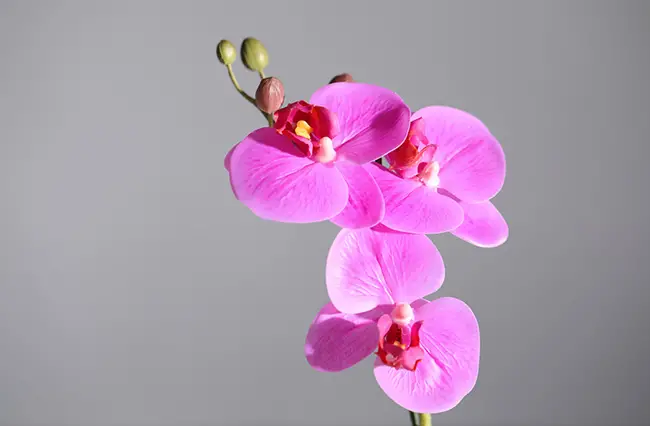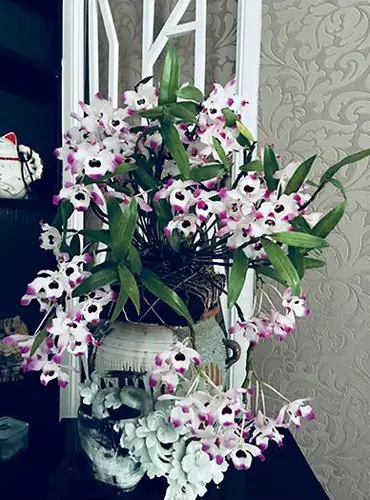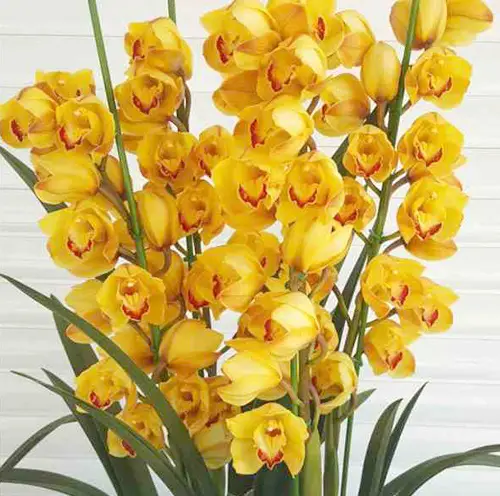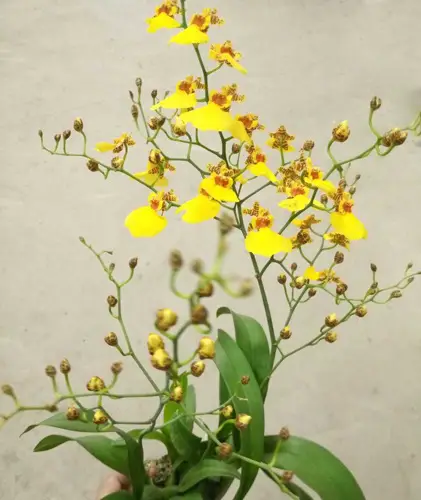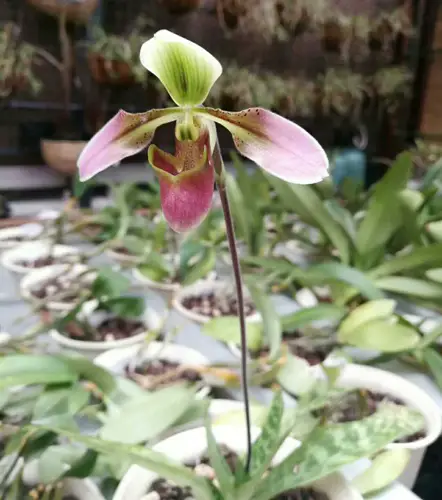Most people unfamiliar with orchids are under the impression that they are these super difficult, headache-inducing plants. Granted, some orchids are very demanding and intricate plants to grow, but for the most part, orchids are fairly easy on the average grower. They have evolved to adapt to their environments over the years, making them the most popular houseplant in the United States easily.
As we are keen on growing orchid flowers, we thought we would help those who are still apprehensive about growing orchids by shedding some light on them in this post.
Here is our list of the top 5 easiest orchids to grow. Even with being very easy to grow and maintain, none of these 5 orchids lack beauty or a wow factor. Therefore, it is just no excuse for you not to try to grow by yourself.
1. Phalaenopsis (fal-en-OP-sis):
Or commonly known as the Moth Orchid tend to be the least expensive, most common, and longest-blooming orchid available. As orchids are now the most popular houseplant in the U.S., the Moth Orchid is the most commonly purchased.
This is due to their ease of care and the fact that one Phalaenopsis bloom will look great for about four months or even longer. The flowers appear in white, pink, red, green, yellow, orange, and purple shades. Plus they can bloom several times a year with proper care.
What’s great about phalaenopsis is that they don’t need much sunlight; just enough so they won’t be too shaded during the day. The best place to keep your plants is away from direct sun, such as near an east-facing window or on top of a bookshelf. When it comes time to water, do not overwater! Instead, wait until the soil feels almost dry before giving them a good soak. This will help avoid any root rot issues down the line. They do best in temperatures from 50 to 75F.
Fertilizer is also important when it comes to caring for phalaenopsis orchids. Use a balanced fertilizer every two weeks during their active growing season (spring and summer). Winter months reduce fertilizing frequency since cooler temperatures slow plant growth significantly. But make sure not to skip fertilization altogether – this could cause nutrient deficiencies which can stunt blooms in future seasons.
Repotting should only take place once every one or two years depending on how quickly your plant outgrows its current container. Make sure you use potting medium specifically designed for epiphytes like orchid bark chips mixed with perlite for optimal draining capabilities.
Helpful Hint: You will see them bloom faster and more regularly with a sudden drop in temperature.
2. Dendrobium (den-DROH-bee-um):
Dendrobium flowers are often seen at florist shops in beautiful bouquets. They have long-lasting blooms, tending to stay vibrant for a month or a little longer. Their blooms can be seen in white, purple, pink, and even green.
Dendrobiums are some of the most popular and easiest orchids to grow. They’re a great choice for beginner gardeners, as they don’t require much care. With bright colors and interesting shapes, these plants make an attractive addition to any home.
They have long stems with clusters of small flowers that can last up to eight weeks. The leaves on dendrobiums are often oval-shaped and leathery in texture. The best part is that you don’t need too much sunlight for them – just indirect light from a window is enough!
When it comes to watering, dendrobiums like moist soil but not soggy conditions. A good rule of thumb is to water once every two weeks and let the top layer of soil dry out before rewatering. You should also fertilize your plant every month during its growing season (usually spring through summer). You will see great success in temperatures from 50 to 70F.
If you want your dendrobiums to bloom again next year, be sure to cut back their stems after flowering has finished. This will encourage more blooms in the future! And with proper care and attention, you’ll soon be rewarded with plenty of beautiful blooms throughout the year.
Helpful Hint: The most common type of the hundreds of Dendrobiums available will keep their foliage throughout the year and bloom off new spikes.
3. Cymbidium (sim-BID-ee-em):
Cymbidium orchids are winter and early spring flourishers. They have waxy, long-lasting blooms and a very easy-care nature, making them popular indoor orchids. Cymbidium orchids thrive in bright light. During the summer, you can even take them outside and place them in a shaded area. Water them once a week to prevent them from drying out. Fertilizing them once a month in the Spring and Summer to see them bloom. Cymbidium’s are happiest in temperatures between 50 to 70F.
This is the orchid genus that many gardeners just love to hate for being so easy to grow. Who would have thought it? These beautiful and delicate flowers can be surprisingly resilient when grown in the right conditions. Here are my top 5 easiest ones to cultivate:
- Cymbidium goeringii – A low-maintenance variety with large white blooms and a pleasant scent.
- Cymbidium ensifolium – Also called ‘sword-leaf’ due to its long narrow leaves, this type has fragrant yellowish-green blossoms.
- Cymbidium finlaysonianum – This one produces multiple sprays of orange-pink blooms which last up to 8 weeks.
- Cymbidium aloifolium – Originating from South East Asia, this species boasts vibrant deep purple flowers.
- Cymbidium dayanum – An evergreen hybrid characterized by its small but stunning pink petals.
So if you’re looking for an easy way into the fascinating world of orchids, why not try starting with one of these cymbidium varieties? They’ll thank you for it!
Helpful Hint: If you want to see your Cymbidium bloom as fast as possible, give it several weeks at cooler temperatures. 50F or a tad under will get your Cymbidium showing its true colors. This is why they are winter-blooming orchids.
Read also: How To Do Orchid Pruning In The Appropriate Way?
4. Oncidium (on-SID-ee-um):
Eloquently referred to as dancing lady orchids, Oncidium offers vibrant collections of 40 or more flowers. They are seen in yellow, purple, white, pink, and red shades, with flashy distinct markings. Oncidiums thrive in medium to bright light.
Oncidium orchids are one of the most popular plants to grow for beginner gardeners. They have bright, colorful flowers and require minimal maintenance, making them ideal for those who don’t want to spend a lot of time caring for their plants. Oncidiums are also quite forgiving if you forget to water them occasionally – they won’t die on you!
Additionally, these plants can survive in low light conditions, so they’re perfect for anyone who doesn’t get much natural sunlight in their home. The best part is that Oncidiums come in a variety of sizes and shapes, so there’s something to suit everyone’s taste. With the right care, your Oncidium will reward you with beautiful blooms all year round.
The key to growing healthy Oncidiums is providing enough humidity. If your home is dry during winter months, try placing your plant near a humidifier or misting it regularly. You should also make sure that your potting mix drains well; otherwise, overwatering could lead to root rot and other problems down the line. Lastly, be sure not to provide too much fertilizer as this can cause leaf burn or yellowing of leaves – just stick with once-a-month feedings and you’ll be good to go. You will see them at their best in temperatures ranging from 50 to 75F.
When it comes to repotting an Oncidium orchid, you should do so every two years since overgrown roots may hinder growth and bloom production. Use a mixture of bark chips and sphagnum moss for optimal air circulation and drainage when choosing your soil mix. Finally, if pruning is necessary due to dead stems or foliage discoloration then use sterile scissors or shears which will help prevent any spread of disease amongst other plants.
These easy-to-care-for beauties definitely make great houseplants whether placed indoors or outdoors – no matter where they live they’ll bring some cheer into any space.
Helpful Hint: The Sharry Baby Oncidium smells like CHOCOLATE!! Add them to your indoor garden for a natural air freshener!
5. Paphiopedilum (paff-ee-oh-PEE-di-lum):
The fifth pick was tough, but we chose the Paphiopedilum or, more commonly and easier to say, The Lady Slipper Orchid. This is probably one of the most distinctive orchids. They offer large blooms with a hollow pouch surrounded by a sepal and two petals on the sides.
Ever since they were first discovered in Asia over two centuries ago, Paphiopedilum has been a source of fascination for gardeners around the world. Like unearthing a rare gemstone, growing and caring for one of these gorgeous plants is an experience unlike any other.
Though some may be intimidated by their divine allure, there’s no need to fear: with just a few simple steps, anyone can cultivate a thriving display of paphiopedilums! Here are five varieties that are especially easy to keep alive and healthy:
Paphiopedilum is a special orchid because they offer multicolored foliage, making them eye candy even when not in bloom. Lady Slippers thrive in low, medium, or bright light. They need to be watered once a week and fertilized once a month in the Spring and Summer.
- The Maudiae vinicolor has stunning white petals that contrast against its deep red veins; it loves bright but indirect light and should not be exposed to temperatures below 60°F (15°C).
- The Ulla Silkens boasts velvety green petals speckled with dark spots – it requires moist soil and medium-to-low levels of humidity.
- The Leucohyle Gold Rush features striking golden petals with maroon edges; this variety enjoys high humidity levels as well as warm temperatures between 68–75°F (20–24°C).
- Stunningly intricate blooms make the Parvisepalum Chico one of the most sought-after paphiopedilums – it prefers partial shade and a consistently damp potting mix.
- Dark purple blotches adorn Paphio rothschildianum’s delicate pink petals; this species likes moderate amounts of water and airy soils such as bark chips or coconut husk fiber.
Helpful Hint: Look for a multi-floral Paphiopedilum such as the Pinocchio Paph. This Lady Slipper will bloom multiple flowers at a time and give you a larger display for a longer time.
Final Thought
So there you go, our top 5 easiest orchids to grow! Now get out there and make an addition to your home with one of these crowd favorites. We swear you won’t lose sleep taking care of them, but you will be caught ogling at them!
Whether you’re just starting out in the world of orchid growing or have been gardening with these beautiful blooms for years, it’s important to know which types will provide maximum enjoyment without too much difficulty. The top five easiest orchids to grow to include Phalaenopsis, Dendrobium, Cymbidium, Oncidium, and Paphiopedilum.
Though each type has its own unique requirements when it comes to watering and light exposure, they all share certain traits such as resilience and ease of maintenance – making them perfect choices for even novice growers. With proper attention given to their specific needs, these five varieties can thrive long-term in any environment. As the old adage goes ‘The best time to plant an orchid was twenty years ago; the second best time is now!’ So why not try your hand at one (or more) of these easy-care beauties today?
When selecting new plants for your garden space be sure to research their individual requirements thoroughly so that you ensure success from the start. Once properly planted and cared for correctly, you should expect nothing but beauty and joy from these fantastic five!
Did you find this post useful? Would you like to get back to it later? Save THIS PIN below for your gardening and orchid garden on Pinterest! Thanks 🙂
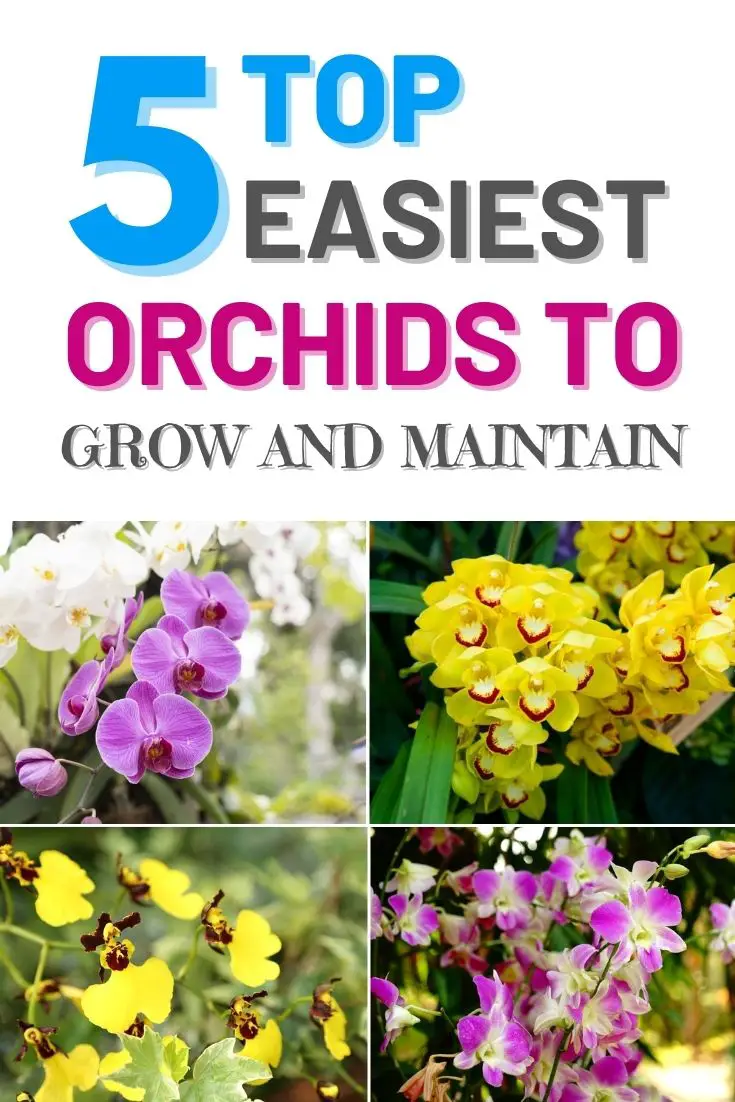
Read also: Top 10 Best Smell Orchids

